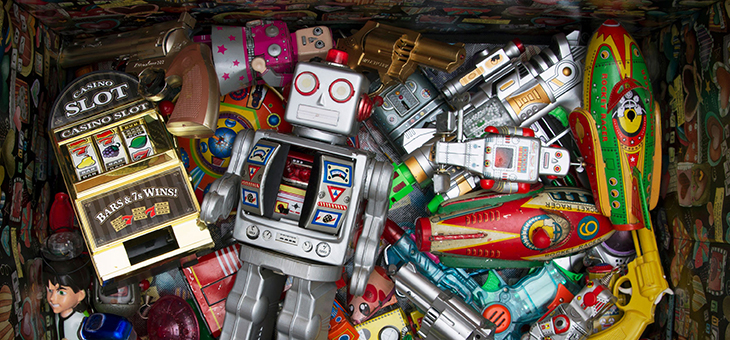Picture a modern child at play, and you probably think iPad, smartphone, or if you’re a little behind the times, MSN. You wouldn’t really be wrong, but a tour of toy shops would reveal a surprising comeback for the old-fashioned, too.
A host of antique toys have risen, phoenix-like, to reclaim their rightful places on our shelves – although often with a new, modern twist.
We spoke to ‘toyologist’ Peter Jenkinson about the rise of retro, and some of the key players making it happen.
Kidults and Kickstarter
The trend has many causes. It’s partly a response to screen saturation – “there’s definitely a pushback against digital, as it’s become such an everyday part of life,” says Mr Jenkinson – but also to a low-risk approach among toy companies.
Further impetus has come from crowdfunding platform Kickstarter – new twists on old games that would never have survived a company pitching meeting can now connect with a fan base directly online. “The board game industry alone has raised something like $9 million on Kickstarter over the last four to five years,” says Mr Jenkinson. “People can more easily pitch ideas – new or based on their own childhood.”
Indeed, adults are showing an increasing willingness to get in touch with their inner child. Last year, 13 per cent of toy sales were purchased by adults either for themselves or for other adults, meaning the ‘kidult’ now commands a sizeable market share.
These older buyers are less swayed by plastic tat than their younger counterparts, and much more prone to nostalgia. “Lego have never had so many 16+ sets,” says Mr Jenkinson.
Here’s a quick rundown of some of the new toys turning back time, from smart board games to shiny pieces of string.
BoomTrix Xtreme Trampoline Action
A deceptively simple game based on spatial awareness, BoomTrix players create long, intricate sequences of hoops, stunts and bounce pads to get one or more ball-bearings from beginning to goal. “It’s based on an Eighties classic called Cascade,” says Mr Jenkinson. “It’s like a complex Newton’s Cradle and can help kids get a little bit of STEM [science, technology, engineering and mathematics].”
Perhaps one of the more surprising comebacks, it’s from the class of creative, tactile classics that was so decimated by the rise of digital. We await with bated breath the return of the hoop and stick.
Augmented Reality Pictionary
Not every retro rebound has to rebuff the delights of digital, and some are opting to synthesise board and screen. You probably know roughly how Pictionary works – draw the word on the card; pass it on; the next person draws what they think you’ve drawn – and following its heyday in the early ’90s, it never wholly disappeared from our shelves.
In this new edition, you quite literally draw in the air, which manifests as an image on surrounding smart devices – massive novelty value if not a major shift in gameplay. “I think it will sell really well,” says Mr Jenkinson.
Rubik’s Cube
A byword for the pleasures and challenges presented by an old-fashioned toy box, the Rubik’s Cube has somehow never really fallen from fashion. Completing one remains a skill of some status, aided by a hotly contested world record based on how quickly you can do it. As of May 2018, the time to beat is 4.22 seconds (yes, seconds).
You might think it difficult to innovate with such a timelessly simple toy, but nevertheless, along came Rubik’s Cube-themed games called Rubik’s Flip and Rubik’s Cage. “It’s colourful and shelf-worthy,” says Mr Jenkinson, “and works for those that can’t do a Cube.”
Ztringz
Perhaps the purest and simplest toy of them all, Ztringz does a spell-checked version of what it says on the tin. “It’s a highly colourful piece of string that’s wax coated so it doesn’t burn your fingers,” says Mr Jenkinson, “and comes with loads of instructions. It’s an update on a classic.”
Like said classic the Cat’s Cradle, children twirl the string around their fingers to make a pattern, and then pass it to a friend to see whether they can do better. It’s not rocket science, and that fact forms the basis of its appeal.
Micro Arcade Pac-Man
Few industries have grown – and therefore dated – as quickly as video games. Since the Seventies and Eighties, giant pixels and low-concept side-scrollers have evolved into boundless sandboxes with Dickensian levels of plotting, and a classic arcade game seems almost Victorian in its quaintness.
Released just two years after Space Invaders, Pac-Man is the original model that so many have since mimicked, and it has now been re-released as a pocket game squeezed onto a device the size of a credit card. “It’s one of those no-fuss devices you can up and play like a game of noughts and crosses,” says Mr Jenkinson. “Of course, you could get it on your phone as an app, but that doesn’t quite have the same nostalgia.”
Jaws: The Board Game
We’re going to guess that if you were charged with making a board game, your first instinct wouldn’t be to base it on a film from 1975. But Jaws has what Mr Jenkinson calls ‘shelf worthiness’.
He explains: “If you have people around, they’ll recognise it and it can be a conversation-starter. It starts a dialogue about something you wouldn’t otherwise get to talk about.”
Overall, board games are leading the analogue renaissance. With more and more board game cafes popping up and whole online forums dedicated to them, the market has been increasing 18–20 per cent year on year.
What was your favourite board game as a kid? Do you still play any? If you could design your own, what would it be?
– With PA
If you enjoy our content, don’t keep it to yourself. Share our free eNews with your friends and encourage them to sign up.
Related articles:
https://www.yourlifechoices.com.au/fun/games/why-board-games-are-booming
https://www.yourlifechoices.com.au/fun/entertainment/scrabble-in-tiptop-shape–at-72
https://www.yourlifechoices.com.au/health/wellbeing/thoroughly-modern-grandparents

